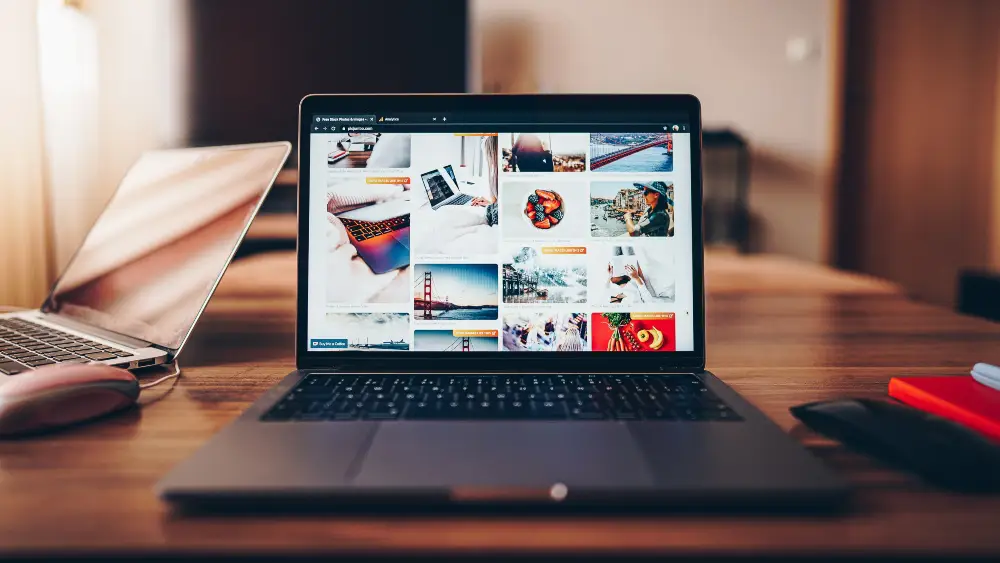This article has been contributed by Dan Martin.
Think about a website you landed on that was just a barrage of text. After a very short time, you probably lost interest and moved on to another website. That is exactly why images are critical to website design.

But it’s not as simple as just using any image anywhere on the page. There are right and wrong ways to select images and place them on web pages.
Read on if you want to make the right choices, using our 11 simple design tips to enhance your use of website images in 2021. We will look at why the judicial use of images is important and how they can bring your website to life.
Types of Images to Use on Your Website
Human beings are visual creatures and we like to see beautiful pictures and images. Anyone designing a website will need to learn how and when to use different types of images. They provide a fantastic way to break up text and allow for better engagement with content.
Whether you are a freelance web designer or you work for a web design company, there are different types of images you should use on your website:
- Logo – this symbol of your brand should appear on every page in a consistent location. Take advantage of logo design trends such as a logo animation for more engagement.
- Photos – these may contain animate or inanimate objects. You can do your own photography or use stock pictures, whether free or paid. You also have the option of using user-generated content, which can have great advantages.
- Illustrations – these allow for customization and originality. Like photos, you can create your own illustrations or use stock versions.
- Charts, tables and infographics – data represented in a visual format are often highly effective for communicating otherwise complex information.
10 Ways to Improve Website Images
1. Create Relevance with Images
Think carefully about the relevance of the images you opt for on your site. For instance, although it may appeal to some Moms, having a buff, half-naked man on a baby’s clothing website isn’t a good choice. Yes, you may grab the attention of Moms, but what are you communicating?
Remember, images are a visual aid. They should convey to your audience exactly what they’ll find on your website. You’re creating a connection through a visual representation. Don’t lose credibility by copying and pasting without investing enough thought in your image choices. Zero relevance in an image may be worse than no image at all.
2. Don’t Use Generic Pictures
Even if your budget is really low, do your best not to resort to stock or free images when designing a website – even if you can only spend up on your main images. Anyone who wants to cut costs will go for generic images, which means your aesthetic may not be unique and original.
Consider it a worthwhile investment to create images that effectively communicate your brand personality. And remember that picturing people rather than inanimate objects provides a human touch. You come across as more authentic and more inviting.
3. Optimize Your Website Images
There are three key points you need to consider when optimizing images:
- Do they look good, on all device types?
- Do they load quickly? Pages that are slow to load will have a big impact on traffic to your website. Platforms such as Amazon have done their research and realized the impact. According to the online seller, the company could lose $1.6 billion in sales due to a one-second lag in page loading speeds. Google will also rank you lower than faster sites, which will impact your visibility in organic search results.
- Can search engines find the images quickly?
Do the following when optimizing images for a website:
- Ensure the use of high-quality photographs. Picture resolutions should be 72 DPI for a screen. You can find some fantastic images on platforms like Unsplash, Pixabay, PicJumbo, and Barn Images. However, keep in mind such photos are available to anyone; you might find the same image on other sites.
- If you have the budget, hire a professional photographer. You’ll own the rights to the pictures and have more options and flexibility in their use.
- Compress large files because they could impact page loading speeds.
- Crop images to focus the attention of the audience on what you want them to see. You can get rid of dead space, allowing you to utilize the screen size better.
- Save photographs as JPG rather than PNG, which are too heavy. GIFs work well for animations. Resize the images to reduce the size but be sure to maintain image clarity. There are plenty of tools available to use for this.
- Use plain but descriptive language when naming your images. Improve your SEO by including relevant keywords in alt text.
- Think about mobile responsiveness when choosing and using images. You don’t want a fantastic user experience on a desktop but a terrible one on mobile. Images may not load properly, or they could even slow down the page speeds.
4. Don’t Just Use One Picture Per Product
Take the time to understand the importance of investing in good pictures, especially for products. Ask your photographer to take multiple photographs from all angles. If your audience cannot interact with the tangible product, the picture will have to do the selling for you. How well can you communicate if you only have one photo?
Applying the right technology can also create positive experiences on your website. Having animated images that can spin 360 degrees allows for better engagement. You’re able to show product details without needing multiple images.
When taking photographs, ensure good lighting so that you capture all relevant details. Avoid shadows and create a good balance with the background.
5. Pay Attention to Homepage Images
Let your primary area of focus be on the homepage. For a lot of your users, it’s their first view of your website – and your brand.
The type and quality of images and content on your homepage will determine whether users stay or bounce. Not only does this affect your ability to convert them onsite – and therefore, your bottom line – but it also impacts your organic rankings. If users leave your site because the images don’t resonate with them, search engines recognize this as a sign of weakness and won’t push your site up in their rankings.
6. Communicate Data with Infographics and Charts
Charts are a great way to communicate data in an engaging format. If there’s plenty of data, combine charts, images and short pieces of text in an infographic.
Infographics eliminate the need to read and analyze complicated rows and columns of text. There are plenty of options in terms of the type of infographics and charts you can use.
Graphs, pie charts, and pyramid diagrams are just a few. Remember, the key to using infographics is to break down the complex text into digestible content. Only include what is necessary to successfully convey your message.
When audiences can easily understand your content, the likelihood of viewer interaction and engagement rises. One rule when using infographics is to think about the target audience. Younger people, for example, want information quickly.
7. Consider Dark Mode
A trend that is catching on is the use of dark mode. Using black or another dark color as your background can reduce users’ eye strain and be easier to read in low light settings. It can also evoke certain perceptions – like mystery and drama – which may be particularly useful for your brand.
But be careful – dark mode doesn’t suit all brands’ color palettes and can reduce the impact of emotions that bright colors can induce. Ensure that you follow best practices for using dark mode in web design to ensure that text is legible and images are clearly visible to your audience.
8. Evoke Emotions with Images
When you embark on building your brand, you are looking to connect with your audience at an emotional level. This is the best way to convert people into loyal customers, so it’s what you’re aiming to do when designing your website.
Whatever images you use should evoke some kind of positive emotion. For instance, you may want your audience to feel happy, inspired, motivated, and a part of your brand.
Depending on your brand, there can be something warm and fuzzy about using a mascot. They allow for an element of playfulness that can create bonding experiences with your audience. You also gain more memorability and easier recognition of your brand.
9. Validate Your Product or Brand with Images
Do you prefer text on a testimonial, or do you like to see a face besides the testimonial? Validation or third-party endorsement is a powerful marketing tool. It becomes more powerful when you have a picture of the happy customer. Seeing faces also makes the audience feel like they are dealing with a real company that serves actual people who have needs just like theirs.
10. User-Generated Content Is the Way To Go
If you have never thought about the importance of user-generated content (UGC), here’s a statistic that will make you start. According to the Nielsen Consumer Trust Index, up to 92% of consumers trust UGC more than traditional advertising.
UGC offers plenty of advantages:
- It is cost-effective; you do not need to spend money on a photographer.
- You get third party endorsements.
- You increase engagement rates when audiences feel that there is more authenticity in what is on your site. Research shows that engagement levels are 2.4 times higher with UGC.
- You increase your chances of conversions due to the trust people have in UGCs.
- It gives your company more credibility than when you use stock photographs.
To generate UGC, invite your audience to share images, videos and reviews. You will find a lot of UGC on platforms like YouTube and Instagram.
Take care – there are legal requirements associated with using UGC. Data privacy is a key concern, so you must seek the permission of your contributors to use their content. Give due credit to the owner of the images. Not only is this the professional thing to do, but it makes the user feel a part of your brand when their name appears on your website.
Take advantage of competitions and reward systems to get the best images. See how much a reward will drive people to share their images. You’ll have the opportunity to be more specific about the type and quality of images that you’re looking to include on your site.
Final Thoughts
Break up the monotony of text! Images communicate a lot on a website. We have looked at 10 simple design tips to enhance your website images in 2021.
It’s very important that you do your research on market practices and needs. Understand your target audience so that you can customize your content to suit them. Also, take advantage of existing technology to enhance your images for better engagement.
_
About the author: Dan has had hands-on experience in digital marketing since 2007. He has been building teams and coaching others to foster innovation and solve real-time problems. Dan also enjoys photography and traveling.






